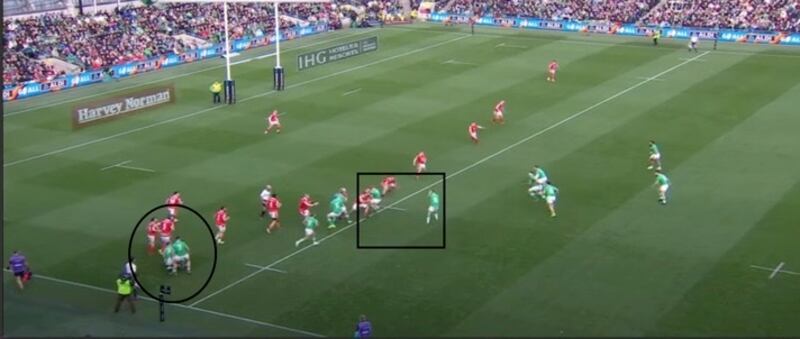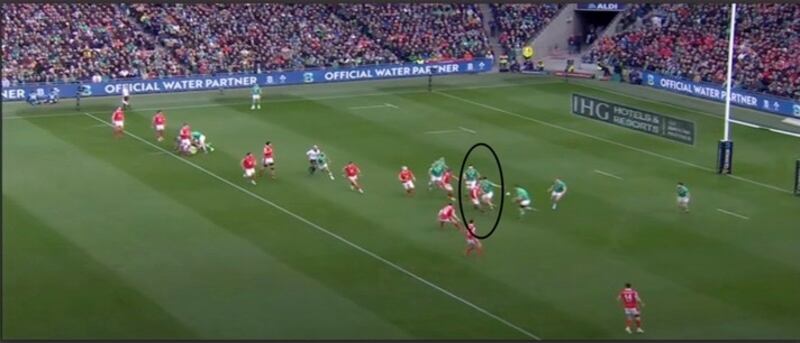In the end, the effect was marginal but Warren Gatland and Wales were relatively pleased with how they fronted up to the challenge of dealing with Ireland’s attack. That said, it is unlikely their game-plan will turn into a blueprint for other sides when they aim to defend against the only side still on track for a Grand Slam.
The most important defensive metric is points conceded. Allowing Ireland to reach 31 on the scoreboard still reflects a tough day at the office for Wales, even if Andy Farrell’s side had to work for the full 80 minutes for their bonus point score.
Ireland made 12 line breaks and 443 post-contact metres vs Wales off 159 carries. Against Italy, where the eye test suggested Ireland’s attack was more fluid, Ireland recorded 12 line breaks and 444 post-contact metres off 168 carries. Ireland had a very similar production against Wales with fewer carries, suggesting a slightly more efficient attacking display.
Despite the overall numbers not being stellar, Wales’ first-half defence is probably what skewed Gatland’s positive perception. “We spoke at half-time and said that basically they didn’t trouble us in phase play, they really didn’t for that first half,” he said.

Wales walloping leaves Ireland one win away from the Six Nations title
“We worked pretty hard on loosening off defensively and following the numbers, splitting our midfield as well. I thought we did a really good job on that.”
Gatland omits that Ireland’s phase play led to a break down the touchline for Robbie Henshaw as early as the first minute. Regardless, Wales’ defensive tactics did surprise Ireland.

“At the breakdown, we thought they’d commit more numbers than they did to poach the ball but they actually sat off and just kept their numbers on the feet,” explains Henshaw. “That gave us that picture in attack that was hard to break down.”
Wales played a numbers game. By not committing bodies on the floor, they hoped to have enough men in the line to deal with decoy lines and runners out the back. However, they didn’t complement this regularly enough with a blitz that stressed the playmaker behind the dummy runner. With quick ball and inconsistent pressure on the decision makers, this Irish attack will break through eventually.
That said, when a defender was faced with a hard-running decoy, a red jersey was able to quickly move off and target the man who actually got the ball, thus dealing with two attackers at once. With red-tinted glasses on, Gatland puts this down to analysis and remaining patient.

A more green-tainted analyst would say that Ireland’s front-door options did not do a good enough job of drawing in defenders. “Wales were able to keep numbers on their feet because we weren’t punching on to the ball,” said Andy Farrell.
“It’s not just the ball carrier but the dummy runners outside them. If they’re not punching on to the ball then they can’t disorganise the defence. It just becomes easy for them to read off and we played too much out the back at times, which made us a bit sideways and more passive than we would have liked.”
When Ireland did most of their attacking damage, in that final passage for Beirne’s bonus point try, the bench offered more of that punch Farrell demanded. What also helped was Welsh fatigue. It’s all well and good not competing for the ball on the floor to keep numbers in the line, but if a defence allows 62 per cent of Irish rucks to be quicker than three seconds, eventually they will be out on their feet.
Farrell was asked on Saturday if the first half frustration offered England a blueprint for how to shut Ireland down in Twickenham. He responded in the negative. England operate completely differently to Wales’ passive ploy, instead flying up to hit the playmaker running behind a decoy. They then swarm over the breakdown once the runner has been caught behind the gain line.
Wales’ tactics could well have been an acknowledgement that they don’t have the cattle to be more aggressive against a side like Ireland. On recent evidence, England may not either, but are adopting a Springbok-inspired blitz under new defence coach Felix Jones. The former apprentice now sees his master, Jacques Nienaber, exposing the Leinster members of this Irish squad — Henshaw included — to his system regularly.
“They’ll be coming harder off the line with that wall,” says Henshaw of the impending challenge at Twickenham. “It’s going to be a tougher test for us over there … We know what Felix experienced down in the South African team. It’s good that we’ll have that bit of knowledge on what we’re coming up against.”






